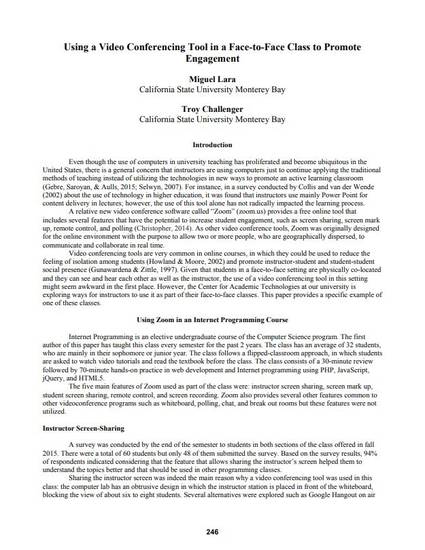
Article
Using a Video Conferencing Tool in a Face-to-Face Class to Promote Engagement
Proceedings from the Annual Meeting of the Association for the Educational Communications and Technology
(2016)
Abstract
Even though the use of computers in university teaching has proliferated and become ubiquitous in the United States, there is a general concern that instructors are using computers just to continue applying the traditional methods of teaching instead of utilizing the technologies in new ways to promote an active learning classroom (Gebre, Saroyan, & Aulls, 2015; Selwyn, 2007). For instance, in a survey conducted by Collis and van der Wende (2002) about the use of technology in higher education, it was found that instructors use mainly Power Point for content delivery in lectures; however, the use of this tool alone has not radically impacted the learning process.
A relative new video conference software called “Zoom” (zoom.us) provides a free online tool that includes several features that have the potential to increase student engagement, such as screen sharing, screen mark up, remote control, and polling (Christopher, 2014). As other video conference tools, Zoom was originally designed for the online environment with the purpose to allow two or more people, who are geographically dispersed, to communicate and collaborate in real time.
Video conferencing tools are very common in online courses, in which they could be used to reduce the feeling of isolation among students (Howland & Moore, 2002) and promote instructor-student and student-student social presence (Gunawardena & Zittle, 1997). Given that students in a face-to-face setting are physically co-located and they can see and hear each other as well as the instructor, the use of a video conferencing tool in this setting might seem awkward in the first place. However, the Center for Academic Technologies at our university is exploring ways for instructors to use it as part of their face-to-face classes. This paper provides a specific example of one of these classes.
Disciplines
Publication Date
2016
Citation Information
Miguel Lara and Troy Challenger. "Using a Video Conferencing Tool in a Face-to-Face Class to Promote Engagement" Proceedings from the Annual Meeting of the Association for the Educational Communications and Technology (2016) p. 246 - 249 Available at: http://works.bepress.com/miguel-lara/10/
